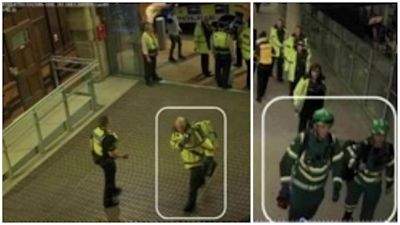Manchester Arena Inquiry: Three paramedics and one stretcher – was it enough?

The decision to only send three paramedics into City Room where the blast happened is one which will come under scrutiny during this inquiry.
The North West Ambulance Service has always maintained it couldn’t send more in without knowing for sure it was safe.
But the police and the public were crying out for ambulances so did it make the right decision, or would more paramedics have made a difference?
WHO WERE THE THREE PARAMEDICS?
Patrick Ennis
Patrick Ennis self-deployed to the Arena within minutes of the blast.
He told the inquiry no amount of training could have prepared him for the scene that met him and that it was the young age of the casualties which shocked him the most.
He went into the City Room where the bomb went off but said it was “not appropriate” for him to start treating casualties because he needed to gain situational awareness. Here he is asking for more ambulances.
Christopher Hargreaves
Christopher Hargreaves was part of the ambulance Hazardous Area Response Team (HART) which is trained to go into a ‘hot zone’ after a bomb attack.
He admitted going on twitter to get information because the control room was “flooded with calls”.
When asked by the Inquiry chairman whether he had a choice over whether to go into the City Room this was his reply:
Lea Vaughan
Lea Vaughan was also part of the HART team and was at a mill fire in Stockport when the blast happened.
By the time she arrives at the Arena it’s 11.07pm.
She told the Inquiry she didn’t think twice about entering the City Room, and makes her way there alongside Christopher Hargreaves.
Counsel to the Inquiry, Paul Greaney QC, asked her: " Was it good enough that only three paramedics were in that room treating those who needed treatment?"
Where was everyone else?
At the time of the explosion only seven ambulances were available.
Instead of being sent straight to the arena they were told to go to a rendezvous point at Thompson Street Fire station half a mile away.
It wasn’t until 11.08pm, 37 minutes after the blast that a convoy of six ambulances arrived at Victoria train station.
This number went up to 25 by 11.15pm and in total 56 ambulances and seven rapid response vehicles were deployed to the incident.
A casualty clearing station was set up on the concourse of Victoria train station where paramedics could safely triage and treat patients.
Helen Mottram was head of triage and told the Inquiry she went from patient to patient making sure no one was missed.
But she admitted she initially didn’t have enough medics to deal with the number of casualties.
Senior paramedic Simon Beswick was the HART team leader. While Chris Hargreaves and Lea Vaughan went into the city room he remained outside with three colleagues treating casualties there.
When asked if he still believed this was the right decision he told the inquiry more specialist paramedics should have been sent in.
Police officer at scene of blast saw just one paramedic looking "completely overwhelmed"
Manchester Arena security firm 'not to blame for staff's inaction', inquiry told
Why weren’t more paramedics sent in?
Fears of a shooter or a secondary device are the reason the ambulance service say they held back.
They didn’t know for sure that it was safe and didn’t want to risk placing more paramedics in danger by sending them into the City Room.
Setting up a casualty clearing station away from where the bomb went off seemed like a safer option.
Meanwhile Greater Manchester Police had declared Operation Plato - the pre-planned response to what they believed was a marauding terrorist firearms attack.
But they didn’t inform fire and ambulance teams.
The inquiry heard how from an ambulance point of view this actually ended up being a good thing because, had they known about Operation Plato, the three paramedics wouldn’t have been allowed into the city room as it was considered to be a “hot zone”.
Would more paramedics have made a difference?
Police officers, first aid staff from the Arena, and members of the public were all in the city room tending to the wounded and, when the decision was made to treat casualties on the station concourse, it also fell to them to move them there.
But they didn’t have any stretchers and had to resort to using metal railings and billboards instead.
Only one actual stretcher was used all night.
If more paramedics had been allowed into City Room, could they have brought stretchers with them to help move casualties?
Or was the real failing the fact the fire service wasn’t there to help?
The inquiry also heard that some critically ill patients waited up to three hours to be taken to hospital due to a shortage of ambulances.
What difference would it have made had they got there sooner?
And crucially could better, faster treatment have helped John Atkinson and Saffie Roussos- the only two victims whose survivability is being considered as part of this inquiry.
The fire service has already apologised for not arriving at the arena for more than two hours, but the ambulance service has always stood by the decisions it made that night.
It'll be for the chairman of this inquiry to decide if those decisions were the right ones.